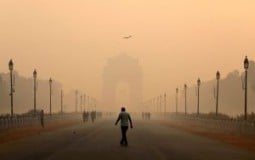Rain occurs within low pressure areas. In a low-pressure area, air rises at the ground. In the Northern Hemisphere, that air rotates counterclockwise over a large area. As the air rises, it cools, water vapor condenses and forms clouds, from which rain can fall. In this case, there was an extreme amount.
Carrousel
The rain clouds revolve around the center of the depression, Siegmund explains. That center was now in the central part of Germany. To the west of it, turning counterclockwise, the showers passed one by one “like a carousel in a large area.”
The rainfall according to the precipitation radar of the KNMI.
The fact that so much rain has fallen now, Siegmund says, is because the depression was “unusually stable.” He stayed in place for a very long time. He doesn’t know why that was the case. There was also so much rain because there is a lot of moisture in the air at the current fairly high, summer temperatures.
According to the KNMI precipitation maps, 72 to 74 mm of rain fell in some places in South Limburg on Wednesday (measured from 10:00 a.m. Wednesday to 10:00 a.m. on Thursday. The day before, there were places where 86, and even 98 mm, were measured. The chance that more than 100 mm of rain will fall in a day is (for that one place) about once a century, the KNMI writes in an explanation about extreme precipitation.
Siegmund says that the low pressure area will move towards the south of Germany this Thursday and will become weaker. Precipitation is still expected for South Limburg during the day, and also in the night to Friday. “But not after that.”
Climate change
The extreme event immediately raised the question of whether this is due to climate change. That is difficult to determine for this one event. But the KNMI does expect more extreme precipitation as the Netherlands, and the earth, warms further. In a warming climate, the amount of water vapor in the air increases by approximately 7 percent per degree of warming. This is what the institute writes in its report on climate scenarios published in 2014. The amount of rain that falls on average in a year has already increased by 26 percent in the Netherlands between 1910 and 2013. That annual average will increase further due to warming. The KNMI also expects an increase in this average in spring, autumn and winter, but this is still uncertain for the summer. What will increase in the summer – as well as in the other seasons – are precipitation extremes, according to the report. Just like the annual average precipitation, these have already increased. For example, the number of days that more than 50 mm falls per day at one particular measuring station in the Netherlands has doubled in the past 50 years. That will increase further. Extreme precipitation in summer can appear in the form of heavy showers, or as rain fronts associated with depressions. They can also occur simultaneously.













